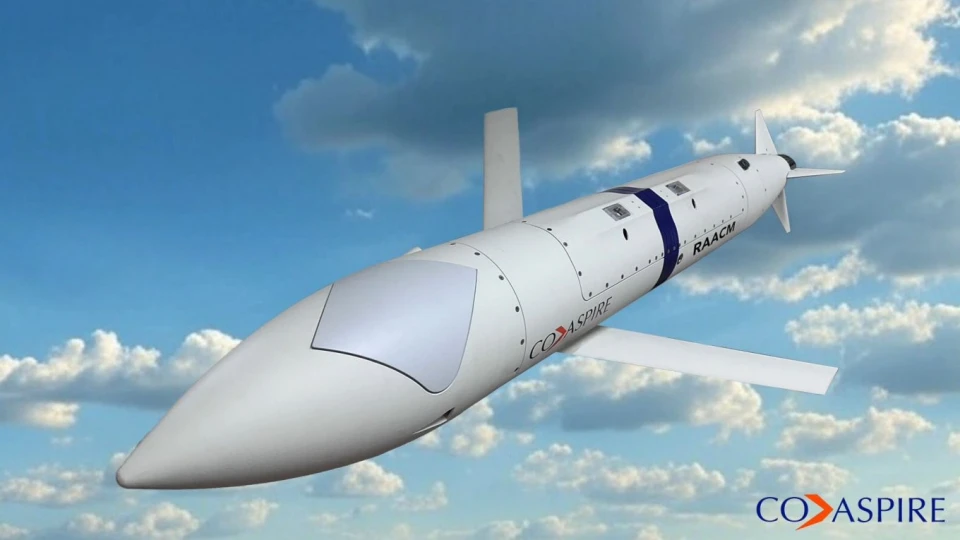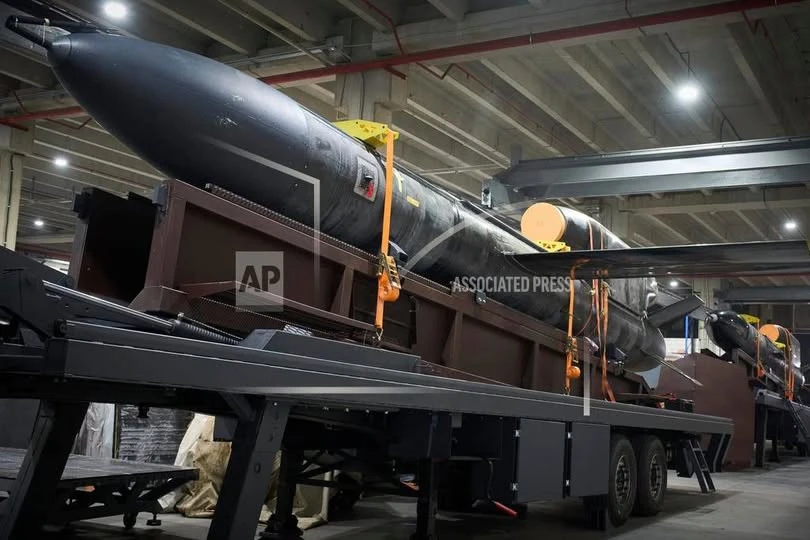Why U.S. ERAM missile deliveries are crucial to Ukraine
global.espreso.tv
Wed, 27 Aug 2025 12:37:00 +0300

Contents1. What makes the ERAM missile delivery a revolutionary step2. Financial mechanisms behind the U.S. “missile” decision3. Are restrictions on using American weapons a critical issue: a new factor4. ERAM, Flamingo, and Neptune: synergy of American and Ukrainian capabilitiesWhat makes the ERAM missile delivery a revolutionary stepAfter the "theater of the absurd" in Alaska and the highly positive, but so far fruitless, summit in Washington, the main focus has returned to the front lines. In fact, the further course of history and the fate of the democratic world is being decided on the Russian-Ukrainian front. Summits and meetings serve more as a backdrop, often inadequate and detached from reality. Meanwhile, unlike Trump’s statements and his efforts to “pull” Russia away from China, the concrete decisions of the U.S. administration and Ukraine's European partners regarding arms deliveries carry far greater significance. These deliveries largely determine the resilience and capability of the Ukrainian Defense Forces to continue effectively countering Russian aggression.The news that the U.S. decided to sell Ukraine 3,350 advanced ERAM (Extended Range Attack Munition) missile-bombs was received rather coolly in Ukraine's media space. Neither the aid package’s cost (around $850 million U.S.) nor the ERAM’s range (up to 450 km) inspired optimism among observers. The main criticism from skeptics was that the Trump administration would most likely not allow the use of the precision ERAM missile-bombs on Russian territory. ERAM (Extended Range Attack Munition) missile, photo: CoaspireBut, in my opinion, to sprinkle one’s head with skepticism, it’s worth evaluating the fact of ERAM deliveries a bit more deeply first.First, the Extended Range Attack Munition is essentially an advanced KAB — that is, a 270 kg aerial bomb with a guidance and correction module, as well as a propulsion engine.Second, since December 2023, the Ukrainian Armed Forces have been critically lacking such tools (i.e., long-range guided bombs) to target Russian military infrastructure that supports the offensive movements of the Russian Armed Forces.Third, preliminary data indicate that the ERAM is built on a modular principle, allowing it to be deployed from various aviation platforms, including F‑16s, MiG‑29s, Su‑27s, Su‑24s, and Mirage 2000s, that is, most of the aircraft in service with the Ukrainian Air Force.Moreover, the announced number of missiles (3,350) and the planned start date of the project (October 1 this year) indicate the seriousness of the U.S. intentions to begin large-scale arms deliveries to Ukraine, provided they are funded by European countries.Financial mechanisms behind the U.S. “missile” decisionRecently, NATO introduced PURL (Prioritised Ukraine Requirements List), a mechanism that allows European countries and Canada to purchase U.S. weapons for Ukraine through joint funding, based on a priority list of needs set by Ukraine. So far, about $2 billion in commitments under PURL have been confirmed: $500 million from the Netherlands, $500 million from Denmark + Norway + Sweden, $500 million from Germany, and $500 million from Canada.These two developments, the creation of PURL and the decision to sell ERAM, are clearly connected. This means the principle agreed at the last NATO summit, of Europe financing arms transfers to Ukraine, has begun to work. As a result, the commercialization of U.S. weapons deliveries could remove many restrictions on the types of U.S.-made weapons available to Ukraine. At the same time, restrictions on the use of U.S. weapons by Ukrainian forces on Russian territory will likely remain in place, or even be strengthened. But let’s now examine this through the lens of ERAM deliveries.Are restrictions on using American weapons a critical issue: a new factorIt is clear that allowing unrestricted strikes on Russian territory with U.S. weapons would be terrible news for the Kremlin and a huge bonus for the Ukrainian Defense Forces. However, while the Biden administration limited the use of U.S. weapons on Russian territory out of fear of “escalation,” Trump forbids striking Russia, believing he has a chance to negotiate with Putin to end the war against Ukraine and draw Russia closer to the U.S., thereby weakening its ties with China. For most Ukrainians and Europeans, the U.S. president’s hopes seem completely detached from reality. Unfortunately, U.S. leadership shapes its strategy based on these narratives: China is the main adversary, Russia can be pulled away from Beijing, and as a result, the U.S. can prevail in this global confrontation.Changing Trump’s stance has so far been unsuccessful for both President Zelenskyy and European leaders. Therefore, it should be regarded as an objective aspect of the overall situation. What is important in this context is to make the most effective use of the current U.S. administration’s position. Equally important is that selling a wide range of U.S. weapons to Ukraine, funded by Europe, will primarily impact the front lines.For example, ERAM deliveries will enable strikes on key targets — depots, command posts, logistics hubs, airfields, and air defense systems — across the full depth of the front, including Crimea. Massive use of ERAM could change the operational situation, reduce Russia’s capacity for offensive actions, and disrupt supply and communication chains. Additionally, ERAM’s extended range will increase the safety of Ukrainian pilots using U.S. missile-bombs beyond the reach of Russian air defenses and aviation.It is also important to recall recent news about the Ukrainian Flamingo and Long Neptune missiles.ERAM, Flamingo, and Neptune: synergy of American and Ukrainian capabilitiesAgainst this backdrop, strikes on Russian territory could be carried out using Ukrainian long-range drones and missiles. The presentation of the next missile project, Flamingo, as well as the first video release of the Long Neptune, raises hopes that Ukraine will finally be able to launch massive strikes with cruise and ballistic missiles on key Russian military and industrial targets. The effectiveness of such strikes will have not only a purely military impact but also a significant effect on Trump’s peace efforts. Ukraine’s ability to conduct large-scale missile strikes independently will demonstrate that President Zelenskyy holds “trump cards” that Trump always worries about. Furthermore, any attempt by Trump to forbid Ukraine from striking Russian territory could be used by Kyiv to increase its leverage in the peace process. In other words, if Putin complains to Trump that Ukraine is hitting Russian territory with missiles and Trump demands that Kyiv stop, then Putin would have to agree to a ceasefire, and Ukraine would also halt strikes on Russia.
ERAM (Extended Range Attack Munition) missile, photo: CoaspireBut, in my opinion, to sprinkle one’s head with skepticism, it’s worth evaluating the fact of ERAM deliveries a bit more deeply first.First, the Extended Range Attack Munition is essentially an advanced KAB — that is, a 270 kg aerial bomb with a guidance and correction module, as well as a propulsion engine.Second, since December 2023, the Ukrainian Armed Forces have been critically lacking such tools (i.e., long-range guided bombs) to target Russian military infrastructure that supports the offensive movements of the Russian Armed Forces.Third, preliminary data indicate that the ERAM is built on a modular principle, allowing it to be deployed from various aviation platforms, including F‑16s, MiG‑29s, Su‑27s, Su‑24s, and Mirage 2000s, that is, most of the aircraft in service with the Ukrainian Air Force.Moreover, the announced number of missiles (3,350) and the planned start date of the project (October 1 this year) indicate the seriousness of the U.S. intentions to begin large-scale arms deliveries to Ukraine, provided they are funded by European countries.Financial mechanisms behind the U.S. “missile” decisionRecently, NATO introduced PURL (Prioritised Ukraine Requirements List), a mechanism that allows European countries and Canada to purchase U.S. weapons for Ukraine through joint funding, based on a priority list of needs set by Ukraine. So far, about $2 billion in commitments under PURL have been confirmed: $500 million from the Netherlands, $500 million from Denmark + Norway + Sweden, $500 million from Germany, and $500 million from Canada.These two developments, the creation of PURL and the decision to sell ERAM, are clearly connected. This means the principle agreed at the last NATO summit, of Europe financing arms transfers to Ukraine, has begun to work. As a result, the commercialization of U.S. weapons deliveries could remove many restrictions on the types of U.S.-made weapons available to Ukraine. At the same time, restrictions on the use of U.S. weapons by Ukrainian forces on Russian territory will likely remain in place, or even be strengthened. But let’s now examine this through the lens of ERAM deliveries.Are restrictions on using American weapons a critical issue: a new factorIt is clear that allowing unrestricted strikes on Russian territory with U.S. weapons would be terrible news for the Kremlin and a huge bonus for the Ukrainian Defense Forces. However, while the Biden administration limited the use of U.S. weapons on Russian territory out of fear of “escalation,” Trump forbids striking Russia, believing he has a chance to negotiate with Putin to end the war against Ukraine and draw Russia closer to the U.S., thereby weakening its ties with China. For most Ukrainians and Europeans, the U.S. president’s hopes seem completely detached from reality. Unfortunately, U.S. leadership shapes its strategy based on these narratives: China is the main adversary, Russia can be pulled away from Beijing, and as a result, the U.S. can prevail in this global confrontation.Changing Trump’s stance has so far been unsuccessful for both President Zelenskyy and European leaders. Therefore, it should be regarded as an objective aspect of the overall situation. What is important in this context is to make the most effective use of the current U.S. administration’s position. Equally important is that selling a wide range of U.S. weapons to Ukraine, funded by Europe, will primarily impact the front lines.For example, ERAM deliveries will enable strikes on key targets — depots, command posts, logistics hubs, airfields, and air defense systems — across the full depth of the front, including Crimea. Massive use of ERAM could change the operational situation, reduce Russia’s capacity for offensive actions, and disrupt supply and communication chains. Additionally, ERAM’s extended range will increase the safety of Ukrainian pilots using U.S. missile-bombs beyond the reach of Russian air defenses and aviation.It is also important to recall recent news about the Ukrainian Flamingo and Long Neptune missiles.ERAM, Flamingo, and Neptune: synergy of American and Ukrainian capabilitiesAgainst this backdrop, strikes on Russian territory could be carried out using Ukrainian long-range drones and missiles. The presentation of the next missile project, Flamingo, as well as the first video release of the Long Neptune, raises hopes that Ukraine will finally be able to launch massive strikes with cruise and ballistic missiles on key Russian military and industrial targets. The effectiveness of such strikes will have not only a purely military impact but also a significant effect on Trump’s peace efforts. Ukraine’s ability to conduct large-scale missile strikes independently will demonstrate that President Zelenskyy holds “trump cards” that Trump always worries about. Furthermore, any attempt by Trump to forbid Ukraine from striking Russian territory could be used by Kyiv to increase its leverage in the peace process. In other words, if Putin complains to Trump that Ukraine is hitting Russian territory with missiles and Trump demands that Kyiv stop, then Putin would have to agree to a ceasefire, and Ukraine would also halt strikes on Russia. Ukrainian Flamingo missile with a range of 3,000 km, photo: facebook.com/efrem.lukatskyAt present, this does not seem entirely realistic. However, in the context of a fuel crisis gradually worsening in Russia due to Ukrainian drone strikes, massive missile attacks from Ukraine could lead to a complete collapse of Russia’s petroleum product market.Therefore, paradoxically, the ban on using U.S. weapons against Russia could become a stimulus for even more active development and production of Ukrainian missile systems. As a result, a military-technical balance could emerge: U.S. long-range weapons could significantly alter the situation on the front, including Crimea, while Ukrainian missiles would have a strategic impact on Russia itself and the stability of the Putin regime.What remains is to bring both directions to practical implementation: equip the Air Force with ERAM and launch serial production of Flamingo, Long Neptune, and Ukrainian ballistic missiles.This material was prepared in collaboration with the Consortium for Defense Information (CDI), a project that unites Ukrainian analytical and research organizations and aims to strengthen information support and analytical capabilities in the fields of national security, defense, and geopolitics.
Ukrainian Flamingo missile with a range of 3,000 km, photo: facebook.com/efrem.lukatskyAt present, this does not seem entirely realistic. However, in the context of a fuel crisis gradually worsening in Russia due to Ukrainian drone strikes, massive missile attacks from Ukraine could lead to a complete collapse of Russia’s petroleum product market.Therefore, paradoxically, the ban on using U.S. weapons against Russia could become a stimulus for even more active development and production of Ukrainian missile systems. As a result, a military-technical balance could emerge: U.S. long-range weapons could significantly alter the situation on the front, including Crimea, while Ukrainian missiles would have a strategic impact on Russia itself and the stability of the Putin regime.What remains is to bring both directions to practical implementation: equip the Air Force with ERAM and launch serial production of Flamingo, Long Neptune, and Ukrainian ballistic missiles.This material was prepared in collaboration with the Consortium for Defense Information (CDI), a project that unites Ukrainian analytical and research organizations and aims to strengthen information support and analytical capabilities in the fields of national security, defense, and geopolitics.
 ERAM (Extended Range Attack Munition) missile, photo: CoaspireBut, in my opinion, to sprinkle one’s head with skepticism, it’s worth evaluating the fact of ERAM deliveries a bit more deeply first.First, the Extended Range Attack Munition is essentially an advanced KAB — that is, a 270 kg aerial bomb with a guidance and correction module, as well as a propulsion engine.Second, since December 2023, the Ukrainian Armed Forces have been critically lacking such tools (i.e., long-range guided bombs) to target Russian military infrastructure that supports the offensive movements of the Russian Armed Forces.Third, preliminary data indicate that the ERAM is built on a modular principle, allowing it to be deployed from various aviation platforms, including F‑16s, MiG‑29s, Su‑27s, Su‑24s, and Mirage 2000s, that is, most of the aircraft in service with the Ukrainian Air Force.Moreover, the announced number of missiles (3,350) and the planned start date of the project (October 1 this year) indicate the seriousness of the U.S. intentions to begin large-scale arms deliveries to Ukraine, provided they are funded by European countries.Financial mechanisms behind the U.S. “missile” decisionRecently, NATO introduced PURL (Prioritised Ukraine Requirements List), a mechanism that allows European countries and Canada to purchase U.S. weapons for Ukraine through joint funding, based on a priority list of needs set by Ukraine. So far, about $2 billion in commitments under PURL have been confirmed: $500 million from the Netherlands, $500 million from Denmark + Norway + Sweden, $500 million from Germany, and $500 million from Canada.These two developments, the creation of PURL and the decision to sell ERAM, are clearly connected. This means the principle agreed at the last NATO summit, of Europe financing arms transfers to Ukraine, has begun to work. As a result, the commercialization of U.S. weapons deliveries could remove many restrictions on the types of U.S.-made weapons available to Ukraine. At the same time, restrictions on the use of U.S. weapons by Ukrainian forces on Russian territory will likely remain in place, or even be strengthened. But let’s now examine this through the lens of ERAM deliveries.Are restrictions on using American weapons a critical issue: a new factorIt is clear that allowing unrestricted strikes on Russian territory with U.S. weapons would be terrible news for the Kremlin and a huge bonus for the Ukrainian Defense Forces. However, while the Biden administration limited the use of U.S. weapons on Russian territory out of fear of “escalation,” Trump forbids striking Russia, believing he has a chance to negotiate with Putin to end the war against Ukraine and draw Russia closer to the U.S., thereby weakening its ties with China. For most Ukrainians and Europeans, the U.S. president’s hopes seem completely detached from reality. Unfortunately, U.S. leadership shapes its strategy based on these narratives: China is the main adversary, Russia can be pulled away from Beijing, and as a result, the U.S. can prevail in this global confrontation.Changing Trump’s stance has so far been unsuccessful for both President Zelenskyy and European leaders. Therefore, it should be regarded as an objective aspect of the overall situation. What is important in this context is to make the most effective use of the current U.S. administration’s position. Equally important is that selling a wide range of U.S. weapons to Ukraine, funded by Europe, will primarily impact the front lines.For example, ERAM deliveries will enable strikes on key targets — depots, command posts, logistics hubs, airfields, and air defense systems — across the full depth of the front, including Crimea. Massive use of ERAM could change the operational situation, reduce Russia’s capacity for offensive actions, and disrupt supply and communication chains. Additionally, ERAM’s extended range will increase the safety of Ukrainian pilots using U.S. missile-bombs beyond the reach of Russian air defenses and aviation.It is also important to recall recent news about the Ukrainian Flamingo and Long Neptune missiles.ERAM, Flamingo, and Neptune: synergy of American and Ukrainian capabilitiesAgainst this backdrop, strikes on Russian territory could be carried out using Ukrainian long-range drones and missiles. The presentation of the next missile project, Flamingo, as well as the first video release of the Long Neptune, raises hopes that Ukraine will finally be able to launch massive strikes with cruise and ballistic missiles on key Russian military and industrial targets. The effectiveness of such strikes will have not only a purely military impact but also a significant effect on Trump’s peace efforts. Ukraine’s ability to conduct large-scale missile strikes independently will demonstrate that President Zelenskyy holds “trump cards” that Trump always worries about. Furthermore, any attempt by Trump to forbid Ukraine from striking Russian territory could be used by Kyiv to increase its leverage in the peace process. In other words, if Putin complains to Trump that Ukraine is hitting Russian territory with missiles and Trump demands that Kyiv stop, then Putin would have to agree to a ceasefire, and Ukraine would also halt strikes on Russia.
ERAM (Extended Range Attack Munition) missile, photo: CoaspireBut, in my opinion, to sprinkle one’s head with skepticism, it’s worth evaluating the fact of ERAM deliveries a bit more deeply first.First, the Extended Range Attack Munition is essentially an advanced KAB — that is, a 270 kg aerial bomb with a guidance and correction module, as well as a propulsion engine.Second, since December 2023, the Ukrainian Armed Forces have been critically lacking such tools (i.e., long-range guided bombs) to target Russian military infrastructure that supports the offensive movements of the Russian Armed Forces.Third, preliminary data indicate that the ERAM is built on a modular principle, allowing it to be deployed from various aviation platforms, including F‑16s, MiG‑29s, Su‑27s, Su‑24s, and Mirage 2000s, that is, most of the aircraft in service with the Ukrainian Air Force.Moreover, the announced number of missiles (3,350) and the planned start date of the project (October 1 this year) indicate the seriousness of the U.S. intentions to begin large-scale arms deliveries to Ukraine, provided they are funded by European countries.Financial mechanisms behind the U.S. “missile” decisionRecently, NATO introduced PURL (Prioritised Ukraine Requirements List), a mechanism that allows European countries and Canada to purchase U.S. weapons for Ukraine through joint funding, based on a priority list of needs set by Ukraine. So far, about $2 billion in commitments under PURL have been confirmed: $500 million from the Netherlands, $500 million from Denmark + Norway + Sweden, $500 million from Germany, and $500 million from Canada.These two developments, the creation of PURL and the decision to sell ERAM, are clearly connected. This means the principle agreed at the last NATO summit, of Europe financing arms transfers to Ukraine, has begun to work. As a result, the commercialization of U.S. weapons deliveries could remove many restrictions on the types of U.S.-made weapons available to Ukraine. At the same time, restrictions on the use of U.S. weapons by Ukrainian forces on Russian territory will likely remain in place, or even be strengthened. But let’s now examine this through the lens of ERAM deliveries.Are restrictions on using American weapons a critical issue: a new factorIt is clear that allowing unrestricted strikes on Russian territory with U.S. weapons would be terrible news for the Kremlin and a huge bonus for the Ukrainian Defense Forces. However, while the Biden administration limited the use of U.S. weapons on Russian territory out of fear of “escalation,” Trump forbids striking Russia, believing he has a chance to negotiate with Putin to end the war against Ukraine and draw Russia closer to the U.S., thereby weakening its ties with China. For most Ukrainians and Europeans, the U.S. president’s hopes seem completely detached from reality. Unfortunately, U.S. leadership shapes its strategy based on these narratives: China is the main adversary, Russia can be pulled away from Beijing, and as a result, the U.S. can prevail in this global confrontation.Changing Trump’s stance has so far been unsuccessful for both President Zelenskyy and European leaders. Therefore, it should be regarded as an objective aspect of the overall situation. What is important in this context is to make the most effective use of the current U.S. administration’s position. Equally important is that selling a wide range of U.S. weapons to Ukraine, funded by Europe, will primarily impact the front lines.For example, ERAM deliveries will enable strikes on key targets — depots, command posts, logistics hubs, airfields, and air defense systems — across the full depth of the front, including Crimea. Massive use of ERAM could change the operational situation, reduce Russia’s capacity for offensive actions, and disrupt supply and communication chains. Additionally, ERAM’s extended range will increase the safety of Ukrainian pilots using U.S. missile-bombs beyond the reach of Russian air defenses and aviation.It is also important to recall recent news about the Ukrainian Flamingo and Long Neptune missiles.ERAM, Flamingo, and Neptune: synergy of American and Ukrainian capabilitiesAgainst this backdrop, strikes on Russian territory could be carried out using Ukrainian long-range drones and missiles. The presentation of the next missile project, Flamingo, as well as the first video release of the Long Neptune, raises hopes that Ukraine will finally be able to launch massive strikes with cruise and ballistic missiles on key Russian military and industrial targets. The effectiveness of such strikes will have not only a purely military impact but also a significant effect on Trump’s peace efforts. Ukraine’s ability to conduct large-scale missile strikes independently will demonstrate that President Zelenskyy holds “trump cards” that Trump always worries about. Furthermore, any attempt by Trump to forbid Ukraine from striking Russian territory could be used by Kyiv to increase its leverage in the peace process. In other words, if Putin complains to Trump that Ukraine is hitting Russian territory with missiles and Trump demands that Kyiv stop, then Putin would have to agree to a ceasefire, and Ukraine would also halt strikes on Russia. Ukrainian Flamingo missile with a range of 3,000 km, photo: facebook.com/efrem.lukatskyAt present, this does not seem entirely realistic. However, in the context of a fuel crisis gradually worsening in Russia due to Ukrainian drone strikes, massive missile attacks from Ukraine could lead to a complete collapse of Russia’s petroleum product market.Therefore, paradoxically, the ban on using U.S. weapons against Russia could become a stimulus for even more active development and production of Ukrainian missile systems. As a result, a military-technical balance could emerge: U.S. long-range weapons could significantly alter the situation on the front, including Crimea, while Ukrainian missiles would have a strategic impact on Russia itself and the stability of the Putin regime.What remains is to bring both directions to practical implementation: equip the Air Force with ERAM and launch serial production of Flamingo, Long Neptune, and Ukrainian ballistic missiles.This material was prepared in collaboration with the Consortium for Defense Information (CDI), a project that unites Ukrainian analytical and research organizations and aims to strengthen information support and analytical capabilities in the fields of national security, defense, and geopolitics.
Ukrainian Flamingo missile with a range of 3,000 km, photo: facebook.com/efrem.lukatskyAt present, this does not seem entirely realistic. However, in the context of a fuel crisis gradually worsening in Russia due to Ukrainian drone strikes, massive missile attacks from Ukraine could lead to a complete collapse of Russia’s petroleum product market.Therefore, paradoxically, the ban on using U.S. weapons against Russia could become a stimulus for even more active development and production of Ukrainian missile systems. As a result, a military-technical balance could emerge: U.S. long-range weapons could significantly alter the situation on the front, including Crimea, while Ukrainian missiles would have a strategic impact on Russia itself and the stability of the Putin regime.What remains is to bring both directions to practical implementation: equip the Air Force with ERAM and launch serial production of Flamingo, Long Neptune, and Ukrainian ballistic missiles.This material was prepared in collaboration with the Consortium for Defense Information (CDI), a project that unites Ukrainian analytical and research organizations and aims to strengthen information support and analytical capabilities in the fields of national security, defense, and geopolitics.







